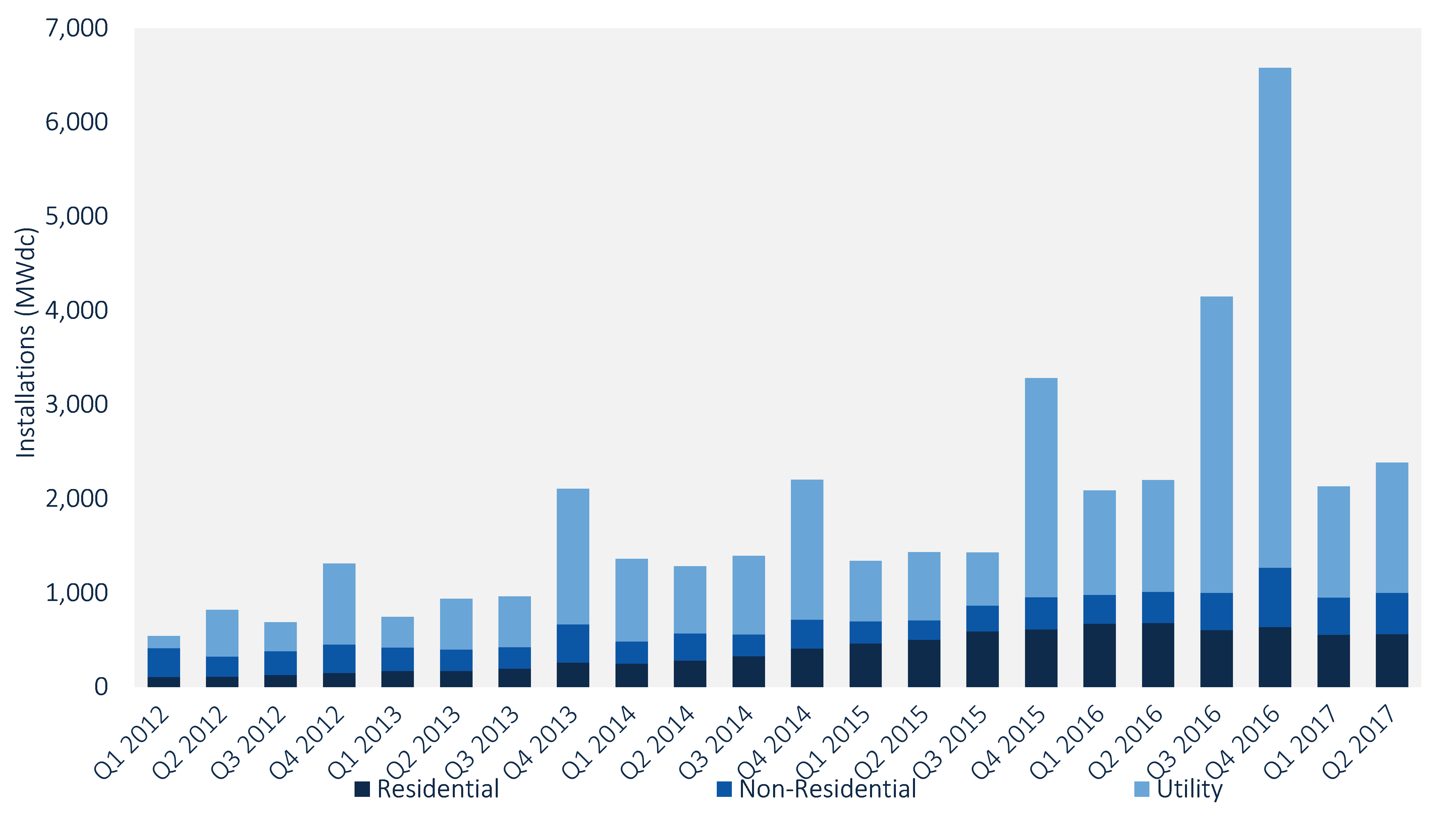

The U.S. solar market continued its years-long expansion in the second quarter of 2017 as the industry installed 2,387 megawatts (MW) of solar photovoltaics (PV), the largest total in a second quarter to date. This tops Q1’s total and represents an 8 percent year-over-year gain, GTM Research and the Solar Energy Industries Association (SEIA) said in the latest U.S. Solar Market Insight Report.
“This report shows once again that solar is on the rise and will continue to add to its share of electricity generation,” said Abigail Ross Hopper, SEIA’s president and CEO. “Last year, solar companies added jobs 17 times faster than the rest of the economy and increased our GDP by billions of dollars. We are going to continue to fight for policies that allow the industry to continue this phenomenal growth.”
All three U.S. solar market segments—commercial, residential and utility-scale—experienced quarter-over-quarter growth in Q2. The U.S. installed 2,044 MW of capacity in Q1. The non-residential and utility-scale market segments also posted year-over-year growth.
FIGURE: U.S. Quarterly PV Installations Q1 2012-Q2 2017

The non-residential market grew a robust 31 percent year-over-year, with 437 MW installed. That was driven in large part by favorable time-of-use rates in California, expiring incentives in Massachusetts, and a record-breaking quarter in New York, where a number of remote, net metered projects were completed.
Joining those states in the top 10 for additions in Q2 were long-time solar leaders such as Arizona, Nevada and North Carolina, as well as surprises like Minnesota and Mississippi, which had the 5th and 9th largest markets in the quarter, respectively. Texas, which is projected to be the second largest state solar market over the next five years, had its strongest quarter ever, adding 378 MW in Q2, placing it 2nd among states this quarter.
The utility-scale segment represented 58 percent of the PV capacity installed in the quarter. In fact, Q2 marked the seventh straight quarter in which the U.S. added more than a gigawatt (GW) of utility-scale solar.
According to the report, 563 MW of residential solar PV was installed in the U.S. in the second quarter of the year. While this is a slight uptick over the first quarter, it represents a 17 percent decline year-over-year.
“Slowdown in residential solar is largely a function of national installers scaling back operations in major state markets as they prioritize profitability over growth,” explained GTM Research Solar Analyst Austin Perea. “While California was the first major market to exhibit signs of slow-down in Q1, many major Northeast markets began to feel the impact of national installer pull-back in Q2 despite a stable policy environment and strong market fundamentals.”
The report forecast that the solar industry will add 12.4 GW of new capacity this year, down slightly from GTM Research’s previous forecast of 12.6 GW.
The report did not change its forecast that the American solar industry would triple cumulative capacity over the next five years.
However, trade relief, which is being considered by the U.S. International Trade Commission, could radically affect the solar outlook and “would result in a substantial downside revision to our forecast for all three segments,” the analysis said.
In a June report, GTM Research said that the requested floor price, if approved, would cut cumulative demand in half over the next five years. SEIA says the petition could cause the solar industry to shed 88,000 jobs just in 2018. Last year, U.S. solar companies added 51,000 workers.
Key Findings
- In Q2 2017, the U.S. market installed 2,387 MWdc of solar PV, an 8 percent increase year-over-year and the largest second quarter ever.
- Through the first half of 2017, 22 percent of all new electric capacity brought online in the U.S. has come from solar, ranking second over that time period to natural gas.
- Suniva’s filing of a Section 201 petition to impose trade remedies on foreign-manufactured cells and modules threatens to significantly reduce PV installations across all segments if accepted in its current form.
- The residential sector grew 1percent quarter-over-quarter. The slow growth rate is caused by relative weakness in the California market and a slowdown in Northeast markets, which are feeling the impact of the pull-back from national providers.
- In contrast to residential PV, the non-residential sector grew 31 percent year-over-year primarily driven by regulatory demand pull-in from policy deadlines in California and Massachusetts.
- Voluntary procurement has emerged as the primary driver of new utility PV procurement, accounting for 59 percent of new procurement through H1 2017.
- Installed system prices remain low across all market segments, with fixed-tilt utility-scale systems remaining under the $1/watt barrier for the second consecutive quarter.
- GTM Research forecasts that 12.4 GWdc of new PV installations will come on-line in 2017.
- Total installed U.S. solar PV capacity is expected to nearly triple over the next five years. By 2022, 31 states will have more than 100 MW annual solar markets—with 25 states being home to more than 1 GW of capacity—and more than 16 GW of solar PV capacity will be installed annually.

 233k
233k  41k
41k  Subscribe
Subscribe 